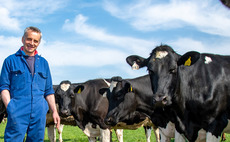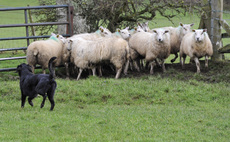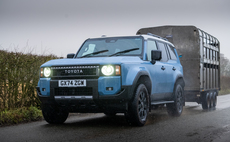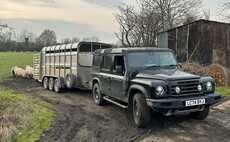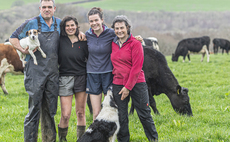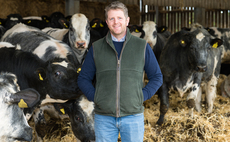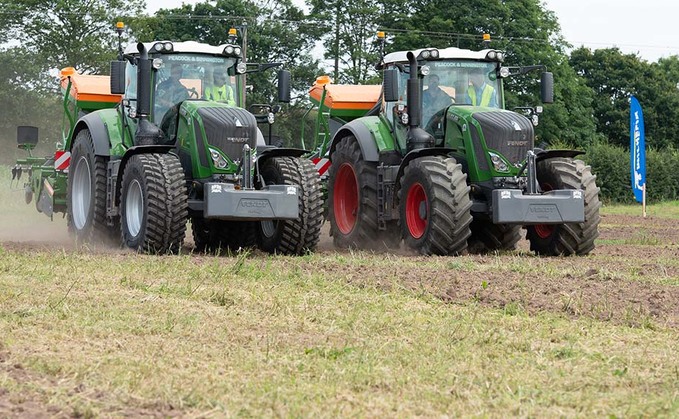
Highlighting the importance of correct tyre choice, we challenged Michelin to an extensive series of field and road tyre trials to find out the difference between its line-up of rubber. James Rickard reports.
By now, it is widely known the importance of correct tyre set-up and the impact it has on tractor performance and soil health. Along with ballast adjustments, tractor pressure can be adjusted to suit a variety of jobs, whether it is using high pressures for transport duties on the road, or cultivating in field with ‘soft' tyres to achieve a large footprint and low ground pressure.
However, as tyre technology continues to develop, there is another major aspect of tyre set-up that is just as important, and that is choosing the right tyres in the first place. After all, you would not go handling cattle in ballet shoes.
But with the likes of Michelin, Mitas, Trelleborg, Continental, Vredestein, Bridgestone and BKT all offering massive product line-ups, the choice can be bewildering with buyers often left unclear as to what they all do. This is not helped by the fact that most tractor tyres look the same, with little indication as to what performance differences each one will bring. Granted, some of the latest tyre designs are now starting to push the boundaries with exotic tread patterns and materials, but are they worth it?
To find out more, we threw down the gauntlet to Michelin and tasked it with proving the difference between its key range of tractor tyres. While this test was conducted with the French manufacturer, the aim is to highlight the importance of tyre selection, no matter which manufacturer they come from.
Our test of tractor tyres was split up into two main areas; fieldwork and roadwork. While both areas took into account fuel use, fieldwork trials concentrated on work rates, traction and the effects on the soil, while roadwork focussed on braking performance, rolling resistance and safety.
As well as Farmers Guardian, also casting an impartial eye on proceedings was expert Philip Wright, an independent soils and cultivations advisor.
Tyres tested
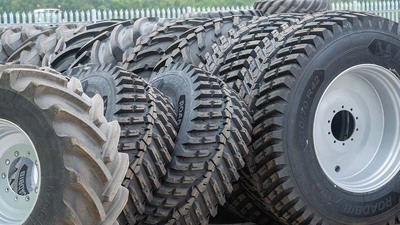
Our tyre choice for both the field and road trials featured five key tractor tyre models from Michelin's line-up, representing a mix of its popular models in the UK and some of its latest developments and specialist tyres. All tyre sizes were 600/70 R30 for the front and 710/70 R42 for the rear.
Tyres included:
- MachXBib: A very popular tyre designed to be hard wearing with high traction characteristics, intended to be an out and out puller, as well as decent on-road capability.
- AxioBib: Designed to be an all-rounder, this tyre builds on MachXBib's traction qualities, but features more ‘flexation' properties to provide a greater footprint and therefore reduce compaction.
- AxioBib2: This has specifically been designed to be gentle on the soil with very high flexation properties, helping to spread the tyre's load in the field while providing increased traction, but still remain safe on the road.
- EvoBib: This is a new development from the manufacturer aimed at tractors fitted with a central tyre inflation system, designed to offer the best of both worlds when it comes to offering low ground pressure for field work and a stable and efficient platform for road work. This is achieved by altering its working pressure which sees an extra set of lugs around the edges of the tyre come into play. At low pressure, these lugs effectively fold down and come into contact with the ground, offering a large footprint. For road, pressure is increased and the tyre rides on it central tread for reduced rolling resistance and increased stability.
- RoadBib: For those that mainly do road work, this tyre has been designed to be hard wearing, provide stable handling and offer a low rolling resistance, but still be able to carry out some field work.
Field trials explained
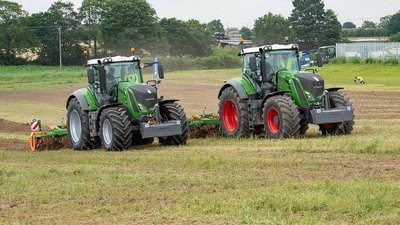
Our field trials were conducted over two days, with day one focussing on traction and performance, and day two looking at field trafficking and compaction.
Day one saw testing carried out during cultivation operations with an Amazone tine cultivator. This provided the necessary draft forces to test for productivity and performance.
Day two was more about the ability to carry a load and still protect the ground. For this, work was carried out using Amazone combination power harrow drills.
Using a 200m course (see field trials conditions panel), tractors and machinery were run side by side for comparison, to find out the different effects of different tyres.
For consistency, two identical tractors, two identical cultivators and two identical combination drills were used (see field trial machinery panel). This allowed us to create a datum tractor, which always used the same tyres, while the second tractor, which swapped its tyres between runs, ran alongside.
This enabled us to take into account variations in each run, yet still have a set of baseline results which could be compared against, giving us a set of consistent test results from one side of the field to the other.
Measurements included tyre footprint, rut depth, water infiltration levels, penetrometer readings, fuel use and work rates (see field trial measurements panel).
Mr Wright says; "Reducing compaction is key when it comes to the drainage of the soil and the ability for roots to develop. If this is compromised, water cannot get to where it needs to be, roots cannot branch out and yields will be reduced."
Field trial measurements
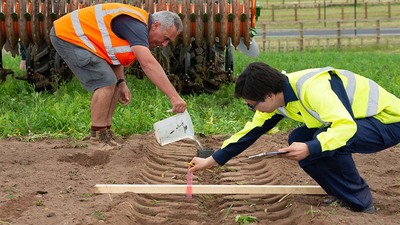
To find out what each tyre was achieving, in terms of performance and soil health, several areas of measurement were carried out:
- Productivity: This was measured by timing how long it took the tractors to complete the course, giving an indication as to what impact each tyre had on work rates.
- Performance: By measuring how much fuel it took the tractors to complete the course, this showed how efficient each set of tyres are at putting the power down and getting the job done.
- Compaction: This is the killer when it comes to reducing yields. To measure this, several areas were looked at including rut depth of each tyre, both in trafficked and untrafficked areas; water infiltration rates in the areas where the tyres ran; and penetrometer readings were also taken. Of all three compaction measurements, water infiltration is the biggest indicator of compaction levels. While a penetrometer is useful, readings can be affected by stone content, so this has to be taken into consideration.
- Trenches: Visual checks below the surface were also looked at, by digging soil trenches and examining the effects of compaction on soil structure. This is a very important method for understanding what is going on below the surface.
- Footprint: To visually see the difference in footprint size between the tyres, sand pits were created to find out the contact patch of each tyre. This was measured with the tyre pressures set at their lowest permissible setting with the drill, and graphically showed how each tyre could spread its weight across the soil surface.
Field trial conditions
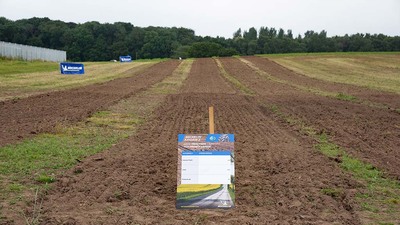
Our field trials test site came courtesy of Amazone UK, at its UK base near Doncaster.
Featuring sandy loam soils with a high sand content and a little bit of stone, soil conditions over the two days were slightly damp, but certainly not sticky. Freely draining on the whole, soil was quite tight due to slump and also featured a cover crop for our cultivators to tackle.
Across the width of the site, soil was very consistent, ideal for comparative testing and consistent results. Weather on day one was cool and overcast, while day two saw temperatures soar.
Our course was 200m long with a slight gradient which plateaued at the top.
It is worth bearing in mind at this point that different field conditions will produce different results, and while our results will give a good indication of the differences between the tyre types, results could vary in other conditions.
In particular, our sandy/frictional soils did appear to play to the strengths of the RoadBib tyre, where soils with a greater clay content could have made it a lot harder for this type of tyre in the field.
Field trial implements
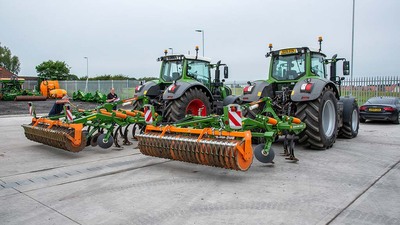
As mentioned, for the field trails two lots of everything was used. On day one of the field trails, to create a draft load and highlight the differences in tyre productivity and performance, Amazone Cenius 3003 Super tine cultivators were used. Working to a depth of 220mm, these mounted machines have a three metre working width and feature tines with a 100mm-wide point and swept wings.
On day two of the field trials, three metre working width Amazone combination drills (its AD-P 3001 drill mounted on a KX3001 power harrow) were used to look at field trafficking and the effects on compaction. Runs with the drill ran up and down the same course, as used by the cultivators the previous day. Each type of tyre also ran its own area as it did the previous day. For example, EvoBib ran where it ran the day before. However, the drill runs were offset by half to the cultivator runs, so that tyres were running on worked and unworked ground, allowing us to effectively compare trafficked and non-trafficked areas.
Mr Wright explains; "When it comes to drilling, the holy grail is to have enough traction to pull the drill, but not create too much compaction so that you need to use track eradicators, which can cause unnecessary soil disturbance.
"Particularly with mounted combi-drills, these can have a nasty habit of quietly transferring weight between the front and rear axles of the tractor. While you need weight on the nose of the tractor to be stable on the headlands, that weight is quickly transferred to the front wheels when the drill is lowered to the ground."
Mr Wright adds; "With a three metre combi-drill, due to compaction, it is possible to reduce yield by up to 50 per cent, which can be far more severe on the headlands. The aim is to get tyre pressures and ballast as ideal as possible and ‘hover' over the ground."
Field trial tractors
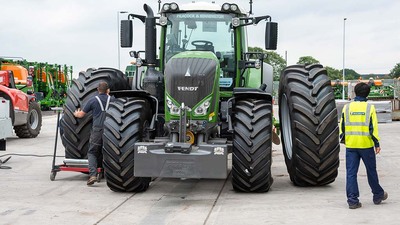
Thanks to Peacock and Binnington, our test tractors included two, Fendt 828 ProfiPlus tractors, both with a continuously variable transmission, which allowed the operators to dial in a target speed and leave the tractors to decide the balance between engine rpm and transmission setting.
For cultivations on day one, a target speed of 10kph was set on the tractors. This gave the tractors a speed to aim for, which took the operator out of the equation, and highlighted how effective each tyre was at getting the power down for our productivity and performance measurements. Keeping things on track, both tractors used guidance.
One tractor acted as the ‘test' tractor, which saw its wheels and tyres changed in between runs, while the other ‘datum' tractor stuck with the same tyres throughout.
The datum tractor was fitted with a set of Trelleborg TM1000 tyres; IF 710/70 R42 on the rear and IF 600/70 R30 on the front.
Ballast included 1,800kg on the nose and none on the rear. With the Cenius 3003 cultivator, this saw tyre loads of 3,050kg each at the front and 4,010kg each at the rear. With the drill, tyre loads were 2,190kg and 4,880kg respectively.
Tyre pressures for day one (traction tests) were set to match the pulling requirements of a heavy draft implement, where day two (compaction tests) tyre pressures where set to ‘carry' the tractor and drill (see below). Pressures were set according to the manufacturer's technical data book.
Field trial tyre pressure settings
Tyres | RoadBib | AxioBib | AxioBib 2 | EvoBib | MachXBib | Datum (Trelleborg TM 1000) |
Traction test front tyre pressure (bar) | ||||||
Traction test rear tyre pressure (bar) | ||||||
Compaction test front tyre pressure (bar) | ||||||
Compaction test rear tyre pressure (bar) |
Road trials explained
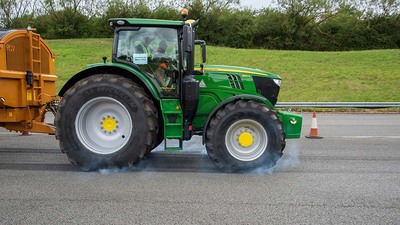
Pretty much opposite to the field trials, the road trial aimed to find out the differences between the tyres when operated under road conditions and at road-operating pressures.
For these trials we headed to the world famous Millbrook proving ground in Bedford. Here, using the site's specialist facilities we could make use of its various courses and test for rolling resistance, fuel use and braking performance.
As with the field trials, two lots of everything were used, including two tractors and two trailers, allowing one tractor to remain as the datum rig and the other the test rig. All tyres tested were the same as tested in the field.
- To test tyre fuel efficiency, the tractors and trailers were subjected to five laps of a two-mile circular test track. This allowed us to keep the tractors at a 40kph set speed with no interruptions. In addition, by using a circular track for this test, the effects of wind resistance were also cancelled out.
- To test rolling resistance, this was done on the site's one mile test strip, which incidentally is 70mm higher at one end compared to the other, to take into account the curvature of the Earth. At the start of the strip is a hill with a 7.5 per cent gradient which the test rigs rolled down, using only gravity as propulsion. The tyres which rolled the furthest would therefore have the least rolling resistance. For a test like this which is in one direction, it was important for us to have the datum tractor and repeat the test to get a good average.
- To test stopping power and safety, dry and wet braking tests were carried out. This test was done on the flat, with the tractor and trailer accelerating up to 30kph then putting on the brakes at a pre-defined braking point.
Road trials test machinery
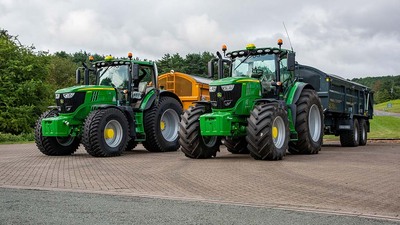
For the road trials, tractors came from the John Deere stable; with a 6175R acting as the datum tractor, fitted with Michelin MultiBib tyres, and the 6195R as the test tractor. Unlike the field trials, the power difference is not an issue for the road trials as much of the testing is to do with rolling resistance and stopping power. Also, conditions are more consistent on tarmac, and any differences between the two are negated by the use of a datum tractor. Overall, it is the differences between the tyres on the test tractor which are important.
Acting as a constant load were two tandem axle Richard Western, RC 16 HC, 16 tonne, root crop trailers. These were filled with soil, to give a train weight of 33 tonnes. As such, tractor front tyre loads were 2,300kg, rear tyre loads were 3,400kg and trailer tyre loads were 5,700kg. Tyre pressures were also set for a 40kph road speed, plus 0.4 bar for intensive road use (see below). All trailer tyre pressures were set to 4.5 bar throughout.
Road trials tyre pressures
Tyres | RoadBib | AxioBib | AxioBib2 | MachXBib | EvoBib | Datum tyres (MultiBib) |
Tractor front tyre pressure (bar) | ||||||
Tractor rear tyre pressure (bar) |
Field and road test results
Tyres tested | AxioBib | AxioBib2 | EvoBib | RoadBib | MachXBib |
Field traction tests (with cultivator) | |||||
Average wheel slip (%) | |||||
Average speed to complete course (kph) | |||||
Fuel used to complete course (l/ha) | |||||
Compaction in wheelings (kPa at 75mm depth) | |||||
Water infiltration rate: trafficked (mm/hr) | |||||
Water infiltration rate: untrafficked (mm/hr) | |||||
Water infiltration rate difference (mm/hr) | |||||
Field compaction tests (with drill) | |||||
Average rut depth in cultivated area (mm) | |||||
Average speed to complete course (kph) | |||||
Compaction in wheelings (kPa at 75mm depth) | |||||
Water infiltration rate: trafficked (mm/hr) | |||||
Water infiltration rate: untrafficked (mm/hr) | |||||
Water infiltration rate difference (mm/hr) | |||||
Rear tyre footprint (sq.m) | |||||
Road tests (with trailer) | |||||
Fuel economy (l/100km) | |||||
Rolling resistance: distance rolled (m) | |||||
Wet braking distance (m) | |||||
Dry braking distance (m) |
MachXBib observations
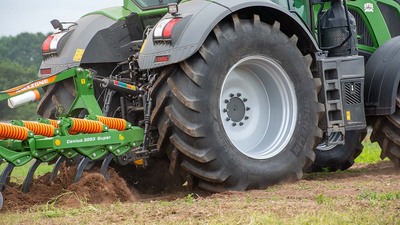
As it was intended to, MachXBib just pulls like a train when cultivating. However, you can see by the compaction tests that this pulling force comes at a price to soil health. Depending on your requirements and conditions, this is maybe the type of tyre you want, but it may also indicate you may need a tyre which is kinder to soils if a lot of tillage work is to be done.
In the braking test, despite this tyre being designed for positive grip not frictional grip, its stopping distance in the dry managed to beat that of the specialist tyres, EvoBib and RoadBib. Under hard braking you could see the front tyres deflecting to such an extent that they just ‘dig in'.
In addition, it is worth mentioning that Michelin has just launch updates to three of its key front tyre dimensions of its MachXBib range, to improve longevity, wear and lateral stability.
AxioBib and AxioBib2 observations
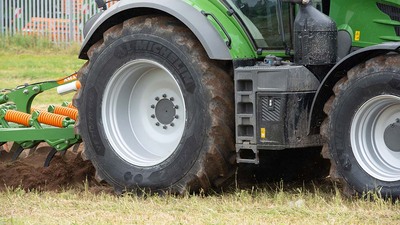
During the 10 mile road run on the two mile circular circuit both the Axio and Axio2 were just as comfy as the speciality RoadBib tyre. However, at slower speeds the vibration from the lugs was more noticeable.
During dry braking, AxioBib2 was definitely one of the more noisy ones and left definite full width skid marks with lots of smoke. This was also one of the most variable under heavy braking, with quite a variation in stopping distances. Under wet braking it also got a little sideways.
However, both the Axio and Axio2 went further than expected on the rolling resistance course, just showing how this tyre has been designed to be ‘lighter' on the ground.
However, when you take into account the field tests, and with just a tweak of the tyre pressures, AxioBib2 really shows itself to be a strong performer in all the tests.
EvoBib observations
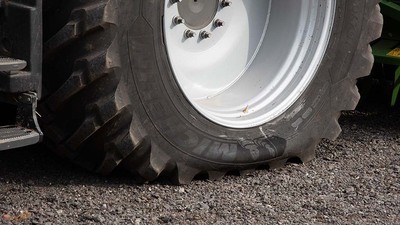
Particularly on day two of the field trials, the extreme low pressure levels of EvoBib made it look like it was laying out its own road, with very shallow rut depth and a massive footprint.
However, with the ability to alter its pressures from one extreme to the other, another area which was highlighted was the effect it had on the tractor's ride height. At low pressure, this will be worth bearing in mind when setting up machinery, particularly mounted implements.
On the road trials, EvoBib did exceptionally well during the rolling resistance test, which showed just how freely it could roll, with only the centre portion of the tread in contact with the tarmac. And with all the tractor's weight riding on this centre portion, it meant stopping performance was also good. But it did raise the question as to how evenly this tyre will wear, as different parts of the tyre are used for different jobs at different times.
Despite having less road to tyre contact than some, it did feel stable and safe under extreme braking and hardly gave off any noise.
RoadBib observations
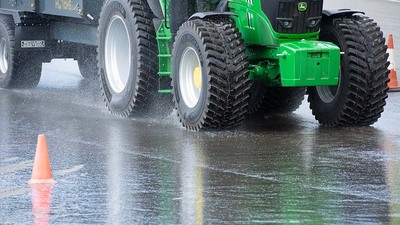
One of the biggest unknowns going into the field trials was whether RoadBib would work or not in the field. But as mentioned, the frictional, sandy soils played into the RoadBib's hands, giving

















